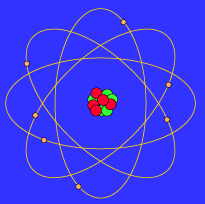Millions of dollars are lost each year because of corrosion. Much of this loss is due to the corrosion of iron and steel, although many other metals may corrode as well. The problem with iron as well as many other metals is that the oxide formed by oxidation does not firmly adhere to the surface of the metal and flakes off easily causing "pitting". Extensive pitting eventually causes structural weakness and disintegration of the metal. (It should be noted, however, that certain metals such as aluminum, form a very tough oxide coating which strongly bonds to the surface of the metal preventing the surface from further exposure to oxygen and corrosion).
Corrosion occurs in the presence of moisture. For example when iron is exposed to moist air, it reacts with oxygen to form rust,
F2O3.XH2O
The amount of water complexed with the iron (III) oxide (ferric oxide) varies as indicated by the letter "X". The amount of water present also determines the color of rust, which may vary from black to yellow to orange brown. The formation of rust is a very complex process which is thought to begin with the oxidation of iron to ferrous (iron "+2") ions.
Fe -------> Fe+2 + 2 e-
Both water and oxygen are required for the next sequence of reactions. The iron (+2) ions are further oxidized to form ferric ions (iron "+3") ions.
Fe+2 ------------> Fe+3 + 1 e-
Tthe electrons provided from both oxidation steps are used to reduce oxygen as shown.
O2 (g) + 2 H2O + 4e- ------> 4 OH-
The ferric ions then combine with oxygen to form ferric oxide [iron (III) oxide] which is then hydrated with varying amounts of water. The overall equation for the rust formation may be written as :
4Fe2+(aq) + O2(g) + [ 4 + 2xH2O (l) ] ---------> 2Fe2O3.XH2O (s) + 8H+ (aq)
rust
The formation of rust can occur at some distance away from the actual pitting or erosion of iron as illustrated below. This is possible because the electrons produced via the initial oxidation of iron can be conducted through the metal and the iron ions can diffuse through the water layer to another point on the metal surface where oxygen is available. This process results in an electrochemical cell in which iron serves as the anode, oxygen gas as the cathode, and the aqueous solution of ions serving as a "salt bridge" as shown below.

The involvement of water accounts for the fact that rusting occurs much more rapidly in moist conditions as compared to a dry environment such as a desert. Many other factors affect the rate of corrosion. For example the presence of salt greatly enhances the rusting of metals. This is due to the fact that the dissolved salt increases the conductivity of the aqueous solution formed at the surface of the metal and enhances the rate of electrochemical corrosion. This is one reason why iron or steel tend to corrode much more quickly when exposed to salt (such as that used to melt snow or ice on roads) or moist salty air near the ocean.



No comments:
Post a Comment